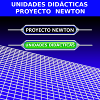LEARNING RESOURCES
-
Electrical phenomena

In this teaching unit you will learn: To describe qualitatively the phenomena of electrification, electrostatic attraction and repulsion and to introduce the concepts of electric charge, insulators and conductors. To justify Coulomb's law and use it to calculate the force exerted by one or two charged particles on another. To intensity and calculate its value in the case of one or two charged particles. To describe the electric field using force lines. To justify the concepts of potential ele...
Área de conocimientoTipo de recursoCollections -
Optics

Didactic unit about optics for 4 º compulsory secondary education . Light as a wave. Reflection. Refraction. An optical device: a telescope. Light as a particle.
Tipo de recursoCollections -
Undulatory phenomena

Didactic unit about waves and undulatory phenomena for 4 º compulsory secondary education course. What is a harmonic vibration? What is a wave? Superposition of waves. Phenomenon of diffraction. Other properties of waves.
Tipo de recursoCollections -
Movement (I)

This teaching unit aims at introducing vectors into the study of movement. There is a revision of the concepts of : Reference system, position and displacement vectors, presented in the 4th year of secondary education (Trajectory) There is a return to fundamental concepts like UM, AUM, UCM presented in previous courses: 2nd year of secondary education:Kinematics; 4th year of secondary education: Rectilinear Movement. and Uniform Circular Movement. Concepts like average and instantaneous veloc...
Área de conocimientoTipo de recursoCollections -
Electric current

In this teaching unit you will learn: To understand the parallelism between an electric circuit and the distribution of water in a closed circuit. To learn the characteristic magnitudes which describe an electric circuit: the potential difference, intensity, resistance, electromotive and counter electromotive force. To demonstrate and understand the fundamental laws which relate these magnitudes. To be able to calculate intensities, tension, power and energy in simple circuits.
Área de conocimientoTipo de recursoCollections -
Linear momentum

Didactic unit about momentum for 4th of compulsory secondary education. Introduction. Momentum and Impulse. Collisions of particles. Disintegration of particles.
Tipo de recursoCollections -
Rectilinear Movement

Didactic unit about Rectilinear Movement for 4th year of compulsory secondary education. Uniform Movement (I). Uniform Movement (II). Uniformly Accelerated Motion (I). Uniformly Accelerated Motion (II).
Tipo de recursoCollections -
Trajectory and displacement

Didactic unit about history and travel for 4th compulsory secondary education. Introduction to the study of movement. Reference System. Trajectory. Displacement.
Tipo de recursoCollections -
Heat engines and machines

In this teaching unit you will learn: To understand the concept of a simple machine as an instrument which saves effort but not work. To understand the way in which energy from wind or water is converted into the mechanical energy of a circular movement. To assimilate the equivalence between mechanical energy and heat. To formulate the first and second law of thermodynamics in a simple way. To learn to use the mathematical formulae for these laws to make simple predictions about the working...
Área de conocimientoTipo de recursoCollections -
Work, Power and Energy

Teaching unit work and energy for 4 º ESO. Work (W). Energy. Work and energy. Power (P) of a force / machine.
Tipo de recursoCollections -
Moving Bodies

Introductory Kinematics teaching unit for 2nd year of Compulsory Secondary Education (ESO) (MEC). Different types of movement. Uniform motion. Accelerated motions. Representations of Movements.
Área de conocimientoTipo de recursoCollections -
Uniform Circular Movement

Didadtic unit on Uniform Circular Movement for 4th year of compulsory secondary education . M.C.U. How to describe it. What is a radian? Angular and linear quantities.
Tipo de recursoCollections -
Statics

Static teaching unit on the 4th year of compulsory secondary education. Magnitude Forces (or Length), Sense and Components of a Force direction. Effect of various forces. Resulting. Balancing force. Activities.
Tipo de recursoCollections


